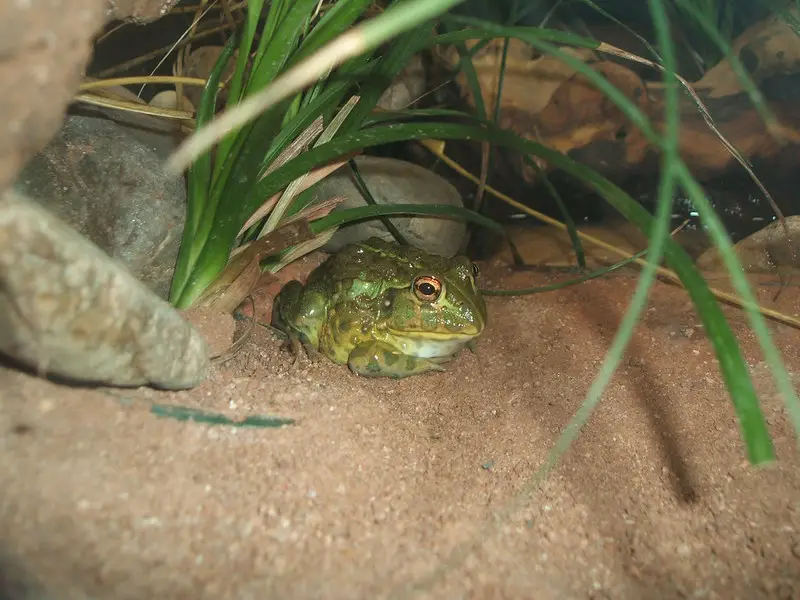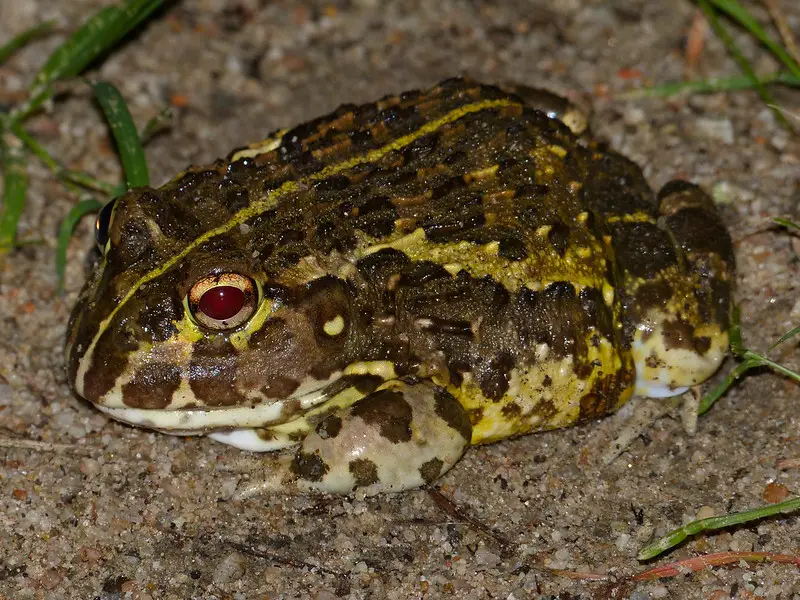African bullfrogs are found primarily in the savannas and grasslands of sub-Saharan Africa. These unique amphibians have a variety of adaptations that make them well-suited for their environment. This article will explore these fascinating creatures’ physical features, habitat, and behavior.
The African bullfrog is known by several other names, including the Cape Bullfrog, Pyxie Frog, or Pixie Frog. Its large size easily identifies it; males can reach up to eight inches long while females only grow half as big. Additionally, both sexes possess a characteristic black stripe running along their backs, giving rise to one of its more common nicknames – the Striped Bullfrog.
This species inhabits open habitats like dry savannas and coastal dunes amongst scrubby vegetation. They feed on small insects, lizards, snakes, mammals, birds, and even smaller frogs. Their diet also includes carrion, with some individuals being able to consume prey twice their body weight! In addition to these impressive hunting abilities, African bullfrogs exhibit complex social behaviors like aggression and territoriality that enable them to survive in their harsh environment.

Anatomy Of The African Bullfrog
The African Bullfrog, also known as Pyxicephalus adspersus, is one of the largest frogs in Africa. Its body size can reach up to 10 inches, and its weight can be as much as 1.5 lbs. It has a wide array of colors ranging from dark shades of green or brown to light yellow and orange hues.
Its head is large, with an enlarged tympanum and two small eyes on either side. The limbs are relatively short compared to other species but have webbed feet that aid them when swimming. The skin possesses many glands that release a toxic substance to protect against predators.
On top of its unique looks, the African bullfrog also has some interesting internal features. For example, it contains four chambers within its heart instead of the usual three found in most amphibians; this gives the frog increased oxygenation capabilities for underwater activities like diving and swimming long distances.
Additionally, their lungs possess specialized sacs that allow them to remain submerged for extended periods without needing to surface for air. Finally, their digestive system consists mainly of stomachs specifically designed for digesting tough insect exoskeletons and plant matter such as leaves and roots.
This adaptation allows them to survive in environments where food sources may not always be available or abundant enough to sustain life elsewhere, thus making them well-suited creatures for inhabiting aquatic and semi-aquatic habitats across much of Sub-Saharan Africa.
Habitat And Range Of The African Bullfrog
The African Bullfrog (Pyxicephalus adspersus) is a frog native to Sub-Saharan Africa and the southern part of the Arabian Peninsula. It inhabits several habitats, from grasslands to savannas and more arid areas and human-made environments such as farmlands. Its range includes East, West, Central, and Southern African countries, including Angola, Chad, Ethiopia, Kenya, Mozambique, Namibia, Nigeria, Somalia, South Sudan, and Zambia.
African bullfrogs are highly adaptable animals that can survive in various environments. They prefer living in places with standing water or moist soil where they can find abundant food sources like insects and other invertebrates. They bury themselves deep underground in the dry season until wetter periods return when they emerge again. Furthermore, some individuals have been found at elevations up to 5500 feet above sea level, indicating their ability to tolerate wide temperature ranges.
The African bullfrog plays an important role in its ecosystem: it consumes insect pests which helps farmers maintain healthy crops; it is also prey for larger predators like birds and reptiles, providing them with food; lastly, it serves as a host for parasites like helminths which help support these organisms’ lifecycles too.
Hunting And Feeding Practices Of The African Bullfrog
The African bullfrog, commonly called the pixie frog, is native to Sub-Saharan Africa. Its hunting and feeding practices are integral components of its ecology. It feeds mainly on insects such as beetles, grasshoppers, and crickets but also consumes smaller vertebrates like reptiles, small mammals, or even other frogs.
African bullfrogs hunt by waiting in an ambush for their prey. They can remain motionless for long periods before striking their target with remarkable speed. When they detect potential prey, they use their tongues to capture them while emitting a loud sound that resembles an explosion when catching large specimens.
As amphibians have no teeth to chew food, African bullfrogs rely instead on powerful muscles around the mouth that help grind down larger chunks of food that would otherwise be too big to swallow whole. This behavior has been observed in adults and juveniles alike, indicating it may be part of the species’ natural behavior rather than something learned from experience.
In addition to these active predation strategies, African bullfrogs will also scavenge carrion if available. Thus, their diet may vary greatly depending on the habitat’s availability. Whatever sources of nutrition they find must contain enough energy to sustain them throughout their lifetime since they generally live up to ten years in captivity.
Do you know how frogs and toads communicate? Find out here
Breeding Habits Of The African Bullfrog
The African bullfrog is a frog found in much of sub-Saharan Africa. Breeding habits for this amphibian are quite specific and have been studied extensively by researchers. The African bullfrog’s primary reproduction mode is through direct egg deposition, meaning that eggs are laid directly from the female onto land. This behavior is seen mainly during periods with higher rainfall and humidity, allowing for optimal conditions for egg development.
To initiate breeding behaviors, males often engage in aggressive vocalizations and physical displays towards one another; these activities establish hierarchy amongst males and attract potential mates. After communication between genders has occurred, mating occurs in shallow water or on wet ground nearby bodies of water such as ponds or rivers. It has been observed that the male may use his hind legs to help hold onto the female while fertilization occurs externally via sperm release into the environment around them.
Once fertilization has taken place, females lay clutches of up to 3200 eggs, hatching after 2–3 days when environmental conditions remain favorable. The tadpoles undergo metamorphosis over two weeks before reaching adulthood at six months old. As they age, adults can reach lengths up to 20 cm long and live upwards of 15 years if provided with proper care and nutrition.
Natural Predators Of The African Bullfrog
The African Bullfrog, native to sub-Saharan Africa and found in Angola, Botswana, Kenya, Mozambique, Namibia, South Africa, Swaziland, and Zimbabwe, is a large frog species most widely distributed amphibian on the continent. They are critical components of their ecosystems as both predator and prey.
When it comes to predators of the African Bullfrog, there is an array of animals, including birds such as Herons or Egrets; mammals like small carnivores like Mongooses or larger ones like Hyenas; Reptiles such as Snakes (including Cobras); fishes like Catfish and even other frogs. The primary defense for these bullfrogs against potential predation is remaining still – freezing in place until the predator passes them by or loses interest in them.
In some cases, however, this may not protect them from becoming another animal’s dinner. For example, if they are caught off guard while moving during nighttime hours and are typically more active than during daytime hours, they tend to hide in caves or underneath rocks due to fear of being discovered by predators. As well as physical defenses such as bright coloring can act as warning signs to would-be predators that they have toxins within their skin that might make them unpalatable.
Common Diseases And Parasites Of The African Bullfrog
The African bullfrog, or Pyxicephalus adspersus, is a large amphibian native to sub-Saharan Africa. This species has become popular in the pet trade industry due to its unique characteristics and distinctive appearance. Despite its popularity, certain illnesses can affect these animals; thus, understanding common diseases and parasites of the African bullfrog is important for proper care and maintenance.
Various fungi have been observed on African bullfrogs’ skin in captivity. These organisms include dermatophytes, Saprolegnia spp., Chytridiomycetes, and other genera. Fungal infections can lead to excessive shedding (skin sloughing), which can be fatal if left untreated.
Additionally, bacterial infections such as Aeromonas hydrophila may result from poor water quality or overcrowded enclosures. Signs of illness typically manifest as ulcers on internal and external organs, including eyes, gills, and ventral surfaces. In more advanced cases, it can cause organ failure resulting in death.
Parasites are another potential health concern for captive African bullfrogs. Protozoan parasites like Giardia duodenalis have been reported in wild specimens, while trematodes such as Clinostomum complanatum were identified mainly in individuals caught from breeding ponds throughout South Africa.
Other helminthic infestations documented among rough models include nematodes belonging to the Rhabdiasidae and cestode larvae from the genus Proteocephalus sp. All parasitic infections should be treated with an appropriate medication prescribed by a veterinarian experienced with reptiles or amphibians.
Proper husbandry practices must be followed to prevent any disease outbreaks within a collection of African bullfrogs maintained in captivity. This includes regular monitoring for signs of illness, providing clean housing conditions with stable temperatures and humidity levels, performing routine fecal examinations when possible, and avoiding overstocking tanks or enclosures to prevent the spread of disease.

Conservation Status Of The African Bullfrog
The African Bullfrog species has been listed as the Least Concern on the IUCN red list since 2004. This amphibian can be found in various African countries, including Botswana, South Africa, and Namibia. Despite being considered an overall stable population size by the International Union for Conservation of Nature (IUCN), some local populations still experience threats from human activities such as hunting, pollution, or habitat loss.
Several conservation efforts have been implemented across its range to ensure the future survival of this species. These include introducing legislation that protects these frogs’ habitats, providing education about their ecological importance, and creating reserves within areas where they naturally occur. In addition to these efforts, captive breeding programs may help conserve wild populations by allowing individuals to be bred and released into suitable natural environments.
Despite numerous conservation initiatives, more research remains necessary to understand how best to protect this species from potential threats posed by humans and other environmental changes. Further action must also be taken for these frogs’ habitats to remain safe over time – only then can we work towards ensuring the long-term persistence of this unique species across its native range.
Interesting Facts About The African Bullfrog
The African bullfrog (Pyxicephalus adspersus) is an amphibian in parts of Africa, including South Africa and Namibia. It has a distinctive appearance with its large size and bright colors. This species is also known for its vocalizations, which can be heard from long distances.
In terms of behavior, the African bullfrog is mainly nocturnal and prefers to stay near water sources such as ponds or streams. During mating season, they are more active during the day. They feed on insects, small animals, worms, and other small invertebrates that they find while searching in leaf litter or shallow waters.
Interesting facts about the African Bullfrog include their ability to burrow underground and aestivate when conditions become too dry or hot to avoid dehydration. Furthermore, egg clutches may contain up to 2,000 eggs, depending on the size of the female frog. The tadpoles then undergo metamorphosis into adult frogs after two months of development. Additionally, these frogs can live up to 10 years in captivity though their natural lifespan is not well established yet.
